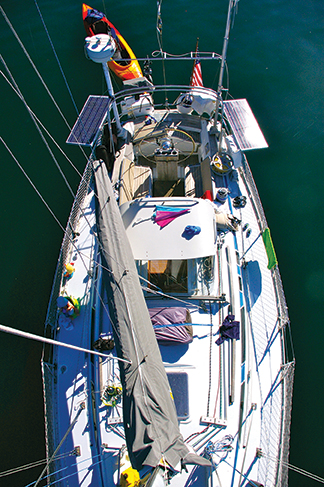(published November 2015)
It was 5:00 a.m. on a Wednesday morning in early August when I heard the pitter-patter of rain on deck above our bunk. The prediction of precipitation had finally come to fruition and the day would be rainy and cloudy until the early evening when the sun finally made a warm and glorious appearance.
This was actually only our first full day of rain since April and our second cloudy day in a row. And due to the lack of sun and wind, and that we had been on anchor without running the engine, Yahtzee’s house batteries had dipped too low for comfort by the time I crawled out of bed an hour or two later. So, for the first time since leaving our permanent slip a year earlier, I fired up the engine at anchor to charge the house batteries.
Getting and using power aboard a cruising boat is always a challenge, and it is tackled in numerous ways by cruisers. While away from shore power, which is most of the time, we have two 80-watt solar panels, a Rutland wind generator and a 70-Amp Motorola alternator. And the biggest power draw for them to contend with is through our refrigerator.
We’ve cruised without a refrigerator before in the Bahamas and lived without one in Ethiopia, so we are well aware that it can be done. But for a family of four, we need to be able to keep our food (and beer) cold, and it’s these alternative energy sources that allow us to do that.
It is a regular occurrence while in a marina or at anchor when another cruiser stops by to chat with me about our solar array and wind generator. They ask how each of them does in providing us with power and I tell them the simple truth—when there’s sun, the solar panels work great, and when there’s wind, the wind generator works great. In general, though, the solar is more effective than the wind for charging but in the Pacific Northwest it really depends on the season.
For days, I wrongly assumed that the problem that led to our need to run the engine at anchor was due to the fact that we hadn’t been plugged into a dock in nearly two weeks; we didn’t have enough consistent sunshine at a peak time of day to get a proper solar charge for two straight days; we hadn’t motored enough to get a proper charge from the alternator; and there hadn’t been enough wind to provide a charge through our wind generator. I was right on at least part of that.
While anchored in Vancouver’s False Creek a few weeks later, I went through the connections on our solar panels and found that one of them was badly corroded and was no longer providing power. That one connection was the culprit. I immediately swapped it out with a watertight repair and the next day our batteries were charging mightily in the late summer sun.
We haven’t run the engine solely for charging since, and it just goes to show that when something is amiss, the answer might be simpler than you think.
Andrew, along with wife Jill and sons Porter and Magnus, are currently cruising the Pacific Northwest aboard their Grand Soleil 39 Yahtzee. Follow their adventures at threesheetsnw.com/yahtzee.

















